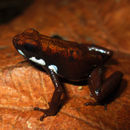fi
nimet breadcrumb-navigoinnissa


Andinobates dorisswansonae, the dotted poison frog, is a species of amphibian in the family Dendrobatidae, endemic to Colombia in the outskirts of Falan and north of the department of Tolima.[1][2] It is toxic to humans.[3]
Its skin is bright black or dark brown with red, orange or yellow spots. It is distinguished in addition to other similar dendrobathids because it has the first and second toes fused, a characteristic that it shares only with a nearby species, Andinobates daleswansoni. Males measure between 16.2 and 17.1 mm in length and females between 17.5 and 19.4 mm. [1]
It lives among the leaf litter, in secondary forests with good canopy and presence of bromeliads, where it deposits its tadpoles, which it cares for and carries on the back to a water source. It feeds on insects, especially ants. [1]
It was discovered by Oscar Javier Gallego Carvajal of the University of Tolima in a fragment of secondary forest of the village of El Llano, in Falan. The description of the species was made together with José Vicente Rueda Almonacid, Marco Rada, Santiago J. Sánchez Pacheco and Alvaro Andrés Velásquez Alvarez, of Conservación Internacional Colombia and was published in Zootaxa in 2006.
It is threatened by habitat loss (logging, farming), hunting, and as a pet/display animal.[2]
Andinobates dorisswansonae, the dotted poison frog, is a species of amphibian in the family Dendrobatidae, endemic to Colombia in the outskirts of Falan and north of the department of Tolima. It is toxic to humans.
La ranita venenosa punteada[3] (Andinobates dorisswansonae), es una especie de anfibio de la familia Dendrobatidae, endémico de las cercanías de Falan, al norte del departamento del Tolima, Colombia.
Su piel es de fondo negro brillante o marrón oscuro con manchas rojas, anaranjadas o amarillas.[3] Se distingue además de otros dendrobátidos similares porque tiene el primer y segundo dedo del pie fusionado, característica que comparte únicamente con una especie cercana, Andinobates daleswansoni. Los machos miden entre 16,2 y 17,1 mm de longitud y las hembras entre 17,5 y 19,4 mm.[2]
Se encuentra entre la hojarasca, en bosques secundarios con buen dosel y presencia de bromelias, donde deposita sus renacuajos, a los que cuida y lleva en el dorso hasta una fuente de agua. Se alimenta de insectos, especialmente de hormigas.[3]
Fue descubierta por Oscar Javier Gallego Carvajal de la Universidad del Tolima en un fragmento de bosque secundario de la vereda El Llano, en Falan. La descripción de la especie fue hecha junto con José Vicente Rueda Almonacid, Marco Rada, Santiago J. Sánchez Pacheco y Álvaro Andrés Velásquez Álvarez, de Conservación Internacional Colombia y fue publicada en Zootaxa en 2006.
La ranita venenosa punteada (Andinobates dorisswansonae), es una especie de anfibio de la familia Dendrobatidae, endémico de las cercanías de Falan, al norte del departamento del Tolima, Colombia.
Su piel es de fondo negro brillante o marrón oscuro con manchas rojas, anaranjadas o amarillas. Se distingue además de otros dendrobátidos similares porque tiene el primer y segundo dedo del pie fusionado, característica que comparte únicamente con una especie cercana, Andinobates daleswansoni. Los machos miden entre 16,2 y 17,1 mm de longitud y las hembras entre 17,5 y 19,4 mm.
Se encuentra entre la hojarasca, en bosques secundarios con buen dosel y presencia de bromelias, donde deposita sus renacuajos, a los que cuida y lleva en el dorso hasta una fuente de agua. Se alimenta de insectos, especialmente de hormigas.
Fue descubierta por Oscar Javier Gallego Carvajal de la Universidad del Tolima en un fragmento de bosque secundario de la vereda El Llano, en Falan. La descripción de la especie fue hecha junto con José Vicente Rueda Almonacid, Marco Rada, Santiago J. Sánchez Pacheco y Álvaro Andrés Velásquez Álvarez, de Conservación Internacional Colombia y fue publicada en Zootaxa en 2006.
Ranitomeya dorisswansonae Ranitomeya generoko animalia da. Anfibioen barruko Dendrobatidae familian sailkatuta dago, Anura ordenan.
Ranitomeya dorisswansonae Ranitomeya generoko animalia da. Anfibioen barruko Dendrobatidae familian sailkatuta dago, Anura ordenan.
Andinobates dorisswansonae est une espèce d'amphibiens de la famille des Dendrobatidae[1].
Cette espèce est endémique du département de Tolima en Colombie[1]. Elle se rencontre à Falan vers 1 780 m d'altitude dans la cordillère Centrale.
Les mâles mesurent de 16,28 à 17,1 mm et les femelles de 17,54 à 19,43 mm[2].
Cette espèce est nommée en l'honneur de la biologiste Doris Swanson[2].
Andinobates dorisswansonae est une espèce d'amphibiens de la famille des Dendrobatidae.
Andinobates dorisswansonae é uma espécie de anfíbio anuro da família Dendrobatidae.[1][2] Está presente na Colômbia.[2] Não foi ainda avaliada pela UICN.[3]
Andinobates dorisswansonae é uma espécie de anfíbio anuro da família Dendrobatidae. Está presente na Colômbia. Não foi ainda avaliada pela UICN.